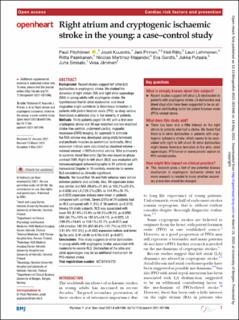| dc.contributor.author | Pöyhönen, Pauli | |
| dc.contributor.author | Kuusisto, Jouni | |
| dc.contributor.author | Pirinen, Jani | |
| dc.contributor.author | Räty, Heli | |
| dc.contributor.author | Lehmonen, Lauri | |
| dc.contributor.author | Paakkanen, Riitta | |
| dc.contributor.author | Martinez-Majander, Nicolas | |
| dc.contributor.author | Gerdts, Eva | |
| dc.contributor.author | Putaala, Jukka | |
| dc.contributor.author | Sinisalo, Juha | |
| dc.contributor.author | Järvinen, Vesa | |
| dc.date.accessioned | 2022-04-21T10:36:55Z | |
| dc.date.available | 2022-04-21T10:36:55Z | |
| dc.date.created | 2022-01-24T14:22:04Z | |
| dc.date.issued | 2021 | |
| dc.identifier.issn | 2053-3624 | |
| dc.identifier.uri | https://hdl.handle.net/11250/2991919 | |
| dc.description.abstract | Background Recent studies suggest left atrial (LA) dysfunction in cryptogenic stroke. We studied the dynamics of right atrium (RA) and right atrial appendage (RAA) in young adults with cryptogenic stroke. We hypothesised that bi-atrial dysfunction and blood stagnation might contribute to thrombosis formation in patients with patent foramen ovale (PFO), as deep venous thrombosis is detected only in the minority of patients.
Methods Thirty patients (aged 18–49) with a first-ever cryptogenic stroke and 30 age-matched and sex-matched stroke-free controls underwent cardiac magnetic resonance (CMR) imaging. An approach to estimate the RAA volume was developed, using crista terminalis and pectinate muscles as anatomical landmarks. Atrial expansion indices were calculated as (maximal volume – minimal volume) ×100%/minimal volume. Total pulmonary to systemic blood flow ratio (Qp/Qs) was based on phase contrast CMR. Right-to-left shunt (RLS) was evaluated with transoesophageal echocardiography in 29 patients and transcranial Doppler in 30 controls, moderate-to-severe RLS considered as clinically significant.
Results We found that RA and RAA volumes were similar between patients and controls. Also, RA expansion index was similar, but RAA (95.6%±21.6% vs 108.7%±25.8%, p=0.026) and LA (126.2%±28% vs 144.9%±36.3%, p=0.023) expansion indices were lower in patients compared with controls. Seven (24%) of 29 patients had an RLS compared with 1 (3%) of 30 controls (p=0.012). Among 59 study subjects, RLS was associated with lower RA (81.9%±15.9% vs 98.5%±29.5%, p=0.030), RAA (84.7%±18% vs 105.6%±24.1%, p=0.022), LA (109.8%±18.6% vs 140.1%±33.7%, p=0.017) and LAA (median 102.9% (IQR 65.6%–121.7%) vs 229.1% (151.8%–337.5%], p=0.002) expansion indices and lower Qp/Qs ratio (0.91±0.06 vs 0.98±0.07, p=0.027).
Conclusions This study suggests bi-atrial dysfunction in young adults with cryptogenic stroke, associated with moderate-to-severe RLS. Dysfunction of the atria and atrial appendages may be an additional mechanism for PFO-related stroke. | en_US |
| dc.language.iso | eng | en_US |
| dc.publisher | BMJ | en_US |
| dc.rights | Navngivelse-Ikkekommersiell 4.0 Internasjonal | * |
| dc.rights.uri | http://creativecommons.org/licenses/by-nc/4.0/deed.no | * |
| dc.title | Right atrium and cryptogenic ischaemic stroke in the young: A case-control study | en_US |
| dc.type | Journal article | en_US |
| dc.type | Peer reviewed | en_US |
| dc.description.version | publishedVersion | en_US |
| dc.rights.holder | Copyright 2021 The Author(s) | en_US |
| dc.source.articlenumber | e001596 | en_US |
| cristin.ispublished | true | |
| cristin.fulltext | original | |
| cristin.qualitycode | 1 | |
| dc.identifier.doi | 10.1136/openhrt-2021-001596 | |
| dc.identifier.cristin | 1988675 | |
| dc.source.journal | Open heart | en_US |
| dc.identifier.citation | Open heart. 2021, 8 (1), e001596. | en_US |
| dc.source.volume | 8 | en_US |
| dc.source.issue | 1 | en_US |

